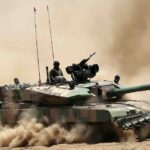
HAL is looking towards building helicopters to retain its position as India’s top performing defence public sector undertaking (DPSU)
By Vikas Gupta
HAL, Bengaluru
Defence News of India, 6th July 24
Since the early-1960s, by designing and building the HF-24 Marut and assembling MiG-21 fighters from Soviet blueprints, Hindustan Aeronautics Ltd (HAL) has built a healthy income stream from fixed wing combat aircraft.
Now, with the income stream from assembling Sukhoi-30MKI fighters running dry, HAL is looking towards building helicopters to retain its position as India’s top performing defence public sector undertaking (DPSU).
HAL’s chief, CB Ananthakrishnan, briefing Defence News of India on an exclusive visit to HAL, says that more than 320 Dhruv advanced light helicopters (ALHs) have been delivered to the army, navy and Indian Air Force (IAF).
Prachanda LCH
In addition, the eponymous Prachanda Light Combat Helicopter (LCH), which has impressed regional air show audiences with its thrilling aerobatics performances, has received its first orders. The Ministry of Defence (MoD) has ordered 10 Prachanda light combat helicopters (LCH) for the Indian Air Force (IAF) and another five for the army.
This is just the tip of the iceberg. The IAF and the army intend to buy 162 Prachanda LCHs – 65 for the IAF and 97 for the army.
The MoD’s hesitant purchase of 15 LCHs is called a Limited Series Production (LSP) order. These choppers will be flown by IAF and army pilots to gauge their performance and capability. They will provide performance feedback and recommend design improvements to HAL.
The 5.8 tonne, twin-pilot Prachanda LCH can operate at altitudes up to 20,000 feet; higher than any other attack helicopter anywhere. It has demonstrated its ability to land on, and take off from, helipads at 15,000 feet altitude at Siachen Glacier with combat loads of fuel and weaponry.
With infantrymen at super-high altitudes unable to carry heavy support weaponry for long distances, a high-altitude attack helicopter like the Prachanda LCH provides invaluable fire support through its on-board, 20-millimetre turret gun, 70-millimetre rockets and air-to-air missiles.
For providing accurate fire support, the Prachanda LCH has cutting-edge target-sighting systems, including an electro-optic pod and a helmet mounted display that allows a pilot to aim at a target just by looking at it.
“[The LCH] is the lightest attack helicopter in the world, designed and developed by HAL to meet the specific and unique requirements of the armed forces,” said Ananthakrishnan.
On building and deploying these helicopters in numbers, HAL’s chief underlines his build strategy: “We have time for delivery till 2024, but the helicopters are ready because we started building these two years ahead of schedule. We have learned to create lead times for ourselves. As soon as the contract is signed, or even before it is signed, we start the procurement of materials,” he says.
Dhruv ALH Mark 3
The army signed its most recent purchase order with HAL in November 2023. With 90 choppers on order, is by far the biggest customer for Dhruv ALH.
Other than the army, the IAF is the biggest Dhruv ALH customer with 66 choppers on order, bringing the total to 156.
HAL has set up a separate 615-acre plant in Tumkur for manufacturing helicopters, which was inaugurated in 2016 by the prime minister. Operating at full capacity, the Tumkur unit will build up to 60 helicopters per year.
“We will definitely establish a robotic production line in Tumkur using the latest manufacturing practices and facilities such as robotic riveting. This will increase the rate of manufacture,” said Ananthakrishnan.
An even more promising machine is the single-engine Light Utility Helicopter (LUH), which HAL hopes to build 400 of. They will replace the tiny, single-engine Chetak and Cheetah helicopters that have done yeoman service for decades.
Rudra helicopter
The Helicopter Complex is abuzz with activity nowadays. Existing programs include an order for 72 Dhruv Mark III helicopter, the armed version of the Dhruv (40 for the Army 16 for the Navy and 16th for the Coast Guard). This contract was signed in 2017 and deliveries are supposed to begin in three years.
Medium helicopters
With a series of light helicopters undergoing flight testing, the development of two medium helicopters is also under way. Designated the Indian Multi-Role Helicopter (IMRH), its development is being led by the Indian Air Force (IAF) for the air force and the army.
Meanwhile, the development of the Deck-Borne Multi-role Helicopter (DB-MRH), a maritime helicopter, has been led by the Indian Navy.
This size of the medium helicopter order would be 419. Out of these, 66 would be DB-MRH for the Navy. The remaining 353 would be IMRHs for the IAF and the army, mainly to replace the Mi-17 series medium helicopters, some of which are approaching obsolescence.
This replacement of the 12.5 to 13 tonne Mi-17-class helicopters will happen in a staggered fashion. The self-protection devices and other facilities on the new Mi-17 V5 choppers will be fitted on the IMRH as well, There are currently about 350 helicopters of the Mi-17-class in service with the IAF.
A key challenge for the IAF in keeping the Mi-17 fleet flying is the extent of supply chain problems that exist with Russia and Ukraine. Spare parts for the Mi-17 class are becoming increasingly difficult to get. One answer is to expand indigenous production. However, we will get also get some assistance from foreign countries in advanced technologies, such as the rotor system and the transmission system.
Engines, as always, can be taken from foreign countries, built under technology transfer, and then establish our own engine production.
This helicopter will carry about 24 odd troops, along with mission-role equipment. The IAF want early deliveries to be planned at a faster rate than normal – about 35 helicopters in another seven years.
For delivering 35 DB-MRH in another seven years, the navy would have to tie up with a foreign original equipment (OEM) for supplying rotors and transmission systems.
HAL has already tied up with French firm, SAFRAN, to establish a joint venture (JV) for manufacture of engines. The outcome would be an all-Indian helicopter with an Indo French engine which would capitalise with our strong existing relationship with Safran.






